Learning to Kitesurf
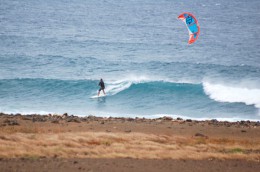
The sea shone tantalizingly, down below us, looking as flat and polished as a mirror, but high up above it we were being buffeted by a strong wind. We were sitting on the summit of Monte Leon, which is a little hill on the coast of Sal.
Down in the bay below ten or fifteen kitesurfers zoomed to and thro, making the best of the wind. Unlike the windsurfers they didn’t need a wind low down, their kites went up high and used the stronger, more consistent wind.
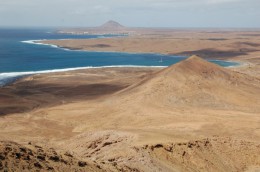
As we watched, another kitesurfer was launching off the back of a catarmaran which was anchored in the bay. His kite floated on the water behind the boat, and when he was ready he jumped into the water and with a pull of the strings he set it soaring into the air above him, shaking water off like a wet dog as it rose. Wheee! Off he went, dragging a white rooster tail of foam behind him. He gybed sharply round and zoomed off to join the ranks of multi-coloured kites zig-zagging up and down outside the bay.
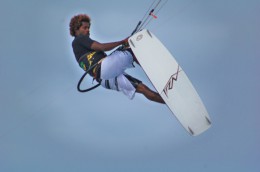
It definitely wasn’t the first time we’d seen kitesurfers, nor was it even the first time we’d thought of learning to kitesurf, but being in Cabo Verde definitely focused our interest because it is just about the number one place in the world for kitesurfing. Speed-sailing records have been set here, and an ex world champion hails from the island of Sal and still lives here. And so it was that we found ourselves considering the pros and cons of learning to kitesurf.
One of the best thing, from our point of view, is that kitesurfing would be a very suitable sport for people who live on a boat. We could kitesurf anywhere we went, provided we had enough wind, and provided we had the right equipment.
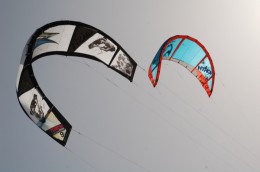
One of the worst things is that the equipment is VERY expensive. And it gets damaged very easily, so it doesn’t last long. We would need a board, which is very much smaller and lighter than a windsurfing board but just as expensive, and we would need at least one kite. We would also need lessons on how to use them – and that would also be very expensive.
Then we remembered that we actually had a kite. We got it second-hand while we were in Spain, and it was very cheap. [We thought we might use it to pull the rubber dinghy along – Jill.] We dug it out and saw that the label said it was 15 metres across. It looked a bit big.
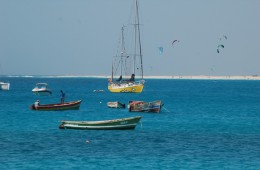
By now we had sailed down to Santa Maria, a village on the south coast of Sal. This has a long, white sand beach with a constant force five or six wind blowing over it, and at the back of the beach there are four kitesurfing schools lined up ready to make use of the perfect conditions. We took our kite ashore to get advice, and we walked along the beach watching the local kitesurfing teachers teaching the tourists in broken English.
We showed our kite to a teacher and he promptly burst out laughing at its age and its size. He called all his mates over to have a look: “15 metres! Look at this, Edny! Did you ever see one of these?”
“So, what size do you use?” we asked.
They used eight or nine metre kites themselves.
“And for the absolute beginners like us?”
“Four metres.”
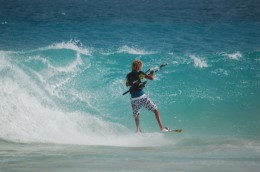
We also checked out prices for lessons. Each school had a different price. The cheapest seemed to be the one at the furthest end of the beacxh, run by two local guys, Mitu Monteiro and his friend Djo. Mitu is the ex word champion kitesurfer. We decided it would be more fun to learn from him and his friends than in a school run by an Italian (Tribal Surf) or an Englishman (Mistral) or a South African (Surf Zone – at the Morabeza Hotel). Anyway, it is always better to suppoort the local people rather than the incomers.
Even though it was the cheapest Mitu’s beginner’s course was still 230 Euros per person (for eight hours tuition).
“That’s much too expensive for all of us to learn,” said Mummy. She has been wanting to learn for ten years, since she saw her first kitesurfers in South Africa. She asked if we could have a discount. Djo said we looked as if we would be quick learners so he would do it for 200 Euros each. But that was still a lot of money.
What could we do?
Well, Daddy wasn’t interested at all, becuase he doesnt like water. So Mummy said that Caesar and I should learn and then we must teach her. She said that we would learn quickest.
We booked our first lesson for the next day.
Of course, what we wanted to do was grab a kite and hop on a board and give it a go, but the first lesson was spent entirely on the beach, learning to fly the kite.
First we tried with “simulators”. These are only about three metres across, but they are shaped so that they pull very strongly.
We were taught by Elvis, a local Cabo Verdean who spoke quite good English. The air around the kite, he said, is like the face of a clock. When the kite is above you it’s at 12 o’clock.
To get the kite to pull you along it has to be to one side of you, in the power zone, as Elvis called it. To move off to one side on a reach, you have to move the kite to and fro between 12 o’clock and 2 o’clock, and to go the other way you have to move it between 12 and 10; up and down, up and down…
When the kite is at 12 o’clock it has hardly any power. Elvis called this place the zenith.
To land the kite you have to put it to one side or the other. You can’t land it behind you (because it can’t go upwind) and you can’t land it in front of you; if you try to it will pull you over and drag you along the ground.
It’s actually pretty easy to understand how to fly the kite if you already know how to manage a sailing boat, because it follows the same basic principles.
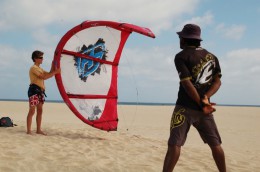
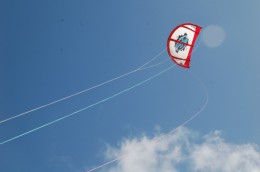
After we had mastered the technique we took turns at flying a bigger, 4m kite. This was a proper kitesurfing kite, and although it was bigger it was much more controlable.
The kites have a bar which the control strings attach to. You put one hand on each side of the bar and steer it rather like riding a bicycle.
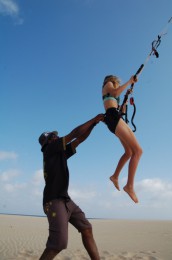
There is a string going through the middle of the bar which is attached onto the harness around your waist. The bar slides up and down on the string. When you push the bar away from you then the kite has a lot less power. Effectively, you have releaased the sheets. When you pull it towards you then you have sheeted in, and it pulls much harder. In my case, the kite was strong enough to pull me off the ground and so I had to have Mummy or Elvis hanging onto me all of the time so that I didn’t blow away. The kite never pulled Caesar over but it did drag him forwards, as if he was water-skiing.
At the end of the lesson Elvis said we could probably go in the water the next day. In it, not on it – because they don’t let you loose with a board until you have shown that you can “body-drag” and control the kite in the water.
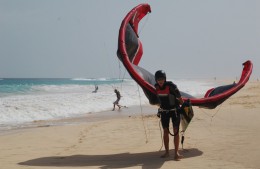
When we arrived the next day Elvis was already getting our kite ready. The kites have an inflatable pipe around the edges, to hold them rigid and to keep them floating when they land on the water.
We took the kite along the beach upwind of the school. It seems that every beginner-kitesurfer spends ten minutes walking upwind for every one minute spent actually trying to kitesurf. Of course, when you know how to kitesurf you can beat upwind just as you can on a sailing boat, but we had a lot to learn before we would be able to do that.
The idea was to reach offshore, gybe (by moving the kite from one side of us to the other, and by turning the upper half of the body to face the other way) and then reach in towards the shore again. To do this we had to keep the kite going in tight figure-of-eights, first between 12 and 2, and then, on the way back in, between 12 and 10.
Elvis accompanied us – each in turn – for the first few times, hanging onto the back of our harnesses. Despite the weight of two people on the kite it still felt incredibly fast, as if I was being towed behind some massive high-speed motor boat. Think how much faster you must go when you are on a board and you haven’t got your body dragging in the water slowing you down…!
Caesar tried it and he also said it was fast, although from the shore he looked as if he was going very slowly.
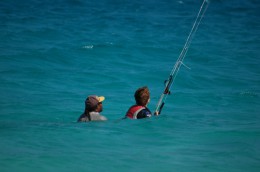
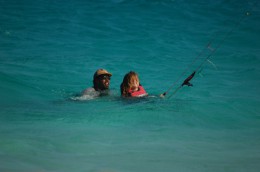
I didn’t actually find handling the kite any harder in the water. If anything it was easier for me, as I didn’t have the weight problem. The water kept me down, and if I accidentally gave the kite too much power all that happened was that we went faster through the water.
Caesar went off without Elvis for his last run, but I didn’t as Elvis reckoned the wind was too strong for me. “I don’t want you to go to Brazil all by yourself, without your yacht!”
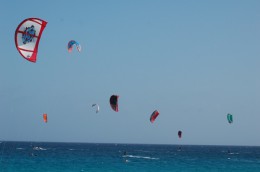
Elvis was on holiday the next day, so Ronnie taught us. He was another local who spoke good English.
I had never actually gone out alone with the four metre kite, so I was a bit alarmed to see him getting a seven metre kite ready.
Ronnie sent Caesar out and he managed fine, although he went quite a bit faster with the bigger kite. I went out and felt as if I was flying. The combination of the bigger kite and the fact that there was only the weight of one little person on the kite mande me go twice as fast as the day before. On several instances I actually left the water!
By now Caesar was learning to beat upwind. He acceived this by flying the kite with one hand and swimming with the other.
Although this does sound like some sort of circus trick Caesar actually did quite well. He had to put his one kite-flying hand in the middle of the bar and instead of going in figures of eight he was trying to keep the kite more or less still. He was still going downwind but not at quite such a rate.
I wasn’t allowed to try this, as Ronnie said it was too windy for me.
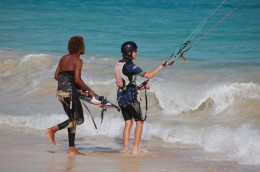
The next day it was just as windy, unfortunately, so I was still stuck with body-dragging. Caesar, however, was getting his first lesson on the board.
The kitesurfing board is smaller in all dimensions than a windsurfer board and very much thinner. It has a big strap at either end to put your feet in. Caesar was given a short demonstration on land, from Ronnie, and then he was sent out to try himself. As he body-dragged away from the beach, with the board in his other hand, Mummy zoomed in on him with her biggest camera lens:
“He’s got his feet in the straps. He’s up! No, he’s down again…”
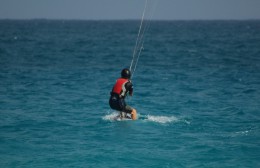
Caesar rose out of the water to his knees and then sank back again.
“He’s not giving the kite enough power,” said Ronnie.
“He’s up again!” Mummy told us (although we could se anyway). “No. He’s down again. Now he’s crashed the kite… He’s got it up again… Yes! No…”
“No, he isn’t moving the kite enough,” said Ronnie.
“He’s up!” said Mummy. “He’s coming in! He’s up! Look!”
Caesar was zooming along, standing rather upright on the board compared to all the experts flitting around him. Caesar reckons he went about ten metres before the board sank under him again.
“Well!” said Ronnie as Caesar came ashore. “You did pretty well! Of course we always tell everybody that they will stand on the board after six hours – otherwise they would go away again without taking lessons – but you’re one of the first people I’ve taught who really has done it!”
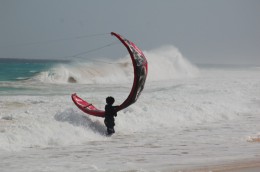
The next day it was even windier, so it seemed pretty pointless me having another lesson, especially as each lesson cost us more money.
Caesar went on the board again and did quite well, although he didn’t think so. Ronnie and Elvis tried to encourage him. They pointed out an Italian guy who had done eleven hours but who still couldn’t stand on the board at all. “He is very cross.”
There were huge waves breaking onto the beach that day, and it was quite difficult getting in and out of the water. I did some body-boarding, but it was a bit scary.
On the sixth day the wind was exactly the same. “Never mind,” we said. “Once Caesar can kitesurf he’ll teach all of us.”
It was Caesar’s last lesson, as the lessons were very expensive – and anyway we wanted to move on from Sal.
After the lesson we went to pay. Mitu and Djo had not asked us to pay in advance. So far we hadn’t paid a penny, and they didn’t even have our names or passport numbers! They knew that we live on a boat and that we could disappear overnight, but they trusted us. Cape verdeans are always very trusting – and very trustworthy.
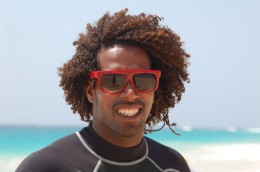
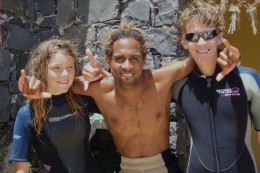
When we said that we had come to pay Elvis got out the diary and added up all of our lessons, and then he said, “Let’s not count that one… or that one…” And in the end the total cost was only 180 Euros for the two of us!
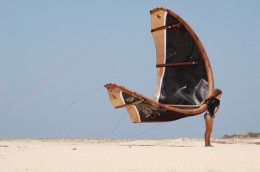
After we had paid we wandered up and down the beach asking about second-hand kit. We were only going to be able to practice if we had our own kite and board. Mitu and Djo wanted 450 Euros for a very well-used ten metre kite which might have burst the first time we flew it. (We had already watched a couple of kites burst – from one side of the cloth to the other – when they were crashed.)
We deicded it would be better to find a less well-used kite.
And what about boards? We had been told by one of the schools that it lost boards at the rate of four per month.
“If each school loses four boards per month then there must be at least 16 boards out there, floating towards Brazil…”
Daddy suggested sailing to and fro downwind of the kitedurfing beach for a few days.
In the end, however, we managed to get a nice board with just a little bit of superficial damage for 100 Euros. That still sounds like an awful lot, but they cost about 600 Euros new!
We still haven’t decided where to get a kite from.
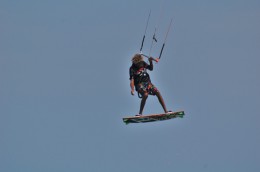
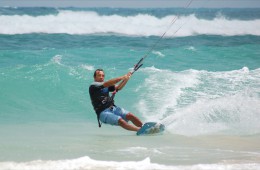
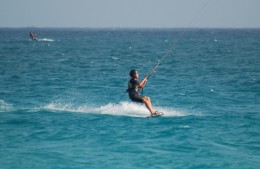
A few days after the lessons had finished we walked over to Kite Beach. This long, sandy, permanently windy beach used to be called Shark Beach, because there were always sharks there. Now everyone calls it Kite Beach… presumably so as not to frighten the tourists.
We walked up and down watching 20 or 30 brightly coloured kites weaving in and out of each other. They were so eager to perform tricks for Mummy’s camera that one of them actually shot right out of the water and landed flat on his back on the beach. Mitu and the others merely shot past leaping and spinning.
“You’ll be doing that one day,” I said to Caesar.
“Hmm.”
So, we are waiting for Caesar to teach us all to be expert kitesurfers. But at the moment he says he is very busy…

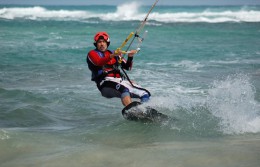
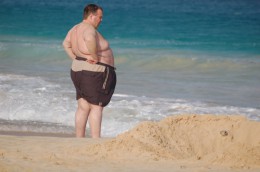
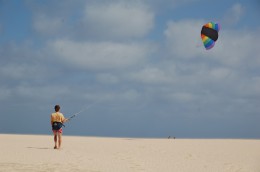
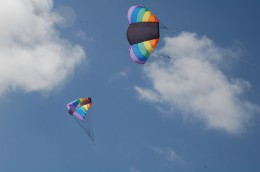
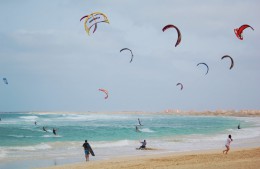
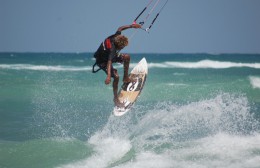
excellent article. well done Roxanne
Not so sure about kite surfing althogh both my boys wnat to try and there is a lot off the beach at wittering!
Adrian
Andy and I now live in Sedgefield……..along the coast (towards Cape Town) from Knysna . It’s a great place to paraglide and we see dozens on a good day.
Kitesurfing is also popular and we have superb beaches that are just right for kite surfing 🙂 So if you ever come down south again you’ll have to sail along to us and see for yourselves!!
Take care and much love
God bless
from Jenny xx